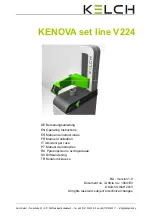
english 13
Controls and features (Fig. 1.1)
1. Headstock
2. Face plate
3. Tool rest with eccentric clamping and release han-
dle
4. Tailstock tip
5. Clamping handle
6. Tailstock
7. Eccentric release handle
(on the back of the tailstock)
8. Drilling bed
9. On/off switch
10. Reversing switch
11. Adjusting lever for engine speed
12. Release handle for headstock
13. Frame feet
14. Sole plates
15. Bottom chassis
m
General Safety Notes
In these operating instructions we have marked the
places that have to do with your safety with this sign
m
• Please pass on safety notes and instructions to all
those who work on the machine.
• Comply with all safety instructions and warnings on the
machine.
• Keep all safety instructions and warnings on the ma-
chine fully legible.
• Check all power supply lines. Do not use defective
lines.
•
Make sure that the machine stands stable on firm
ground.
•
Caution when working: There is a danger to fingers,
hands and eyes.
• Keep children away from the machine when it is con-
nected to the power supply.
• When working on the machine, all safety mechanisms
and covers must be mounted.
• Operating personal must be at least 18 years of age.
Trainees must be at least 16 years of age, but may only
operate the machine under adult supervision.
• Persons working on the machine may not be diverted
from their work.
• The working space on the machine must be free of
chips and wood scrap.
•
Wear only closefitting clothes. Remove rings, brace
-
lets and other jewelry.
• For the safety of long hair, wear a cap or hair net.
• Do not wear gloves.
• Wear goggles when working.
• Note the motor rotational direction – see electrical con-
nection.
• The safety mechanisms on the machine may not be
removed or rendered unusable.
• Cleaning, changing, calibrating, and setting of the
machine may only be carried out when the motor is
switched off. Pull the power supply plug and wait for
the rotating tool to completely stop.
• Switch the machine off and pull power supply plug
when rectifying any malfunctions.
• Connection and repair work on the electrical installa-
tion may be carried out by a qualified electrician only.
• All protection and safety devices must be replaced af-
ter completing repair and maintenance procedures.
• Place the tool support as tightly as possible against the
work piece.
• The peripheral speed of wooden workpieces must not
exceed 25 m/s. Note spindle speed diagram!
• Note the spindle rotation – see reversing switch.
• Provide work pieces with center bores before clamping
between pivots.
• Work large and imbalanced work pieces at a reduced
rotational speed; it may be necessary beforehand to
cut accordingly with a band saw.
• Before switching on the machine, check that the work-
piece is securely clamped.
• Remove the chuck key or spring dowel sleeve before
turning the machine on.
• Always close the belt cover.
• Work with three- or four-jaw chucks may only be car-
ried out with mounted jaw chuck shield.
• Never stop work pieces with the hand during run out.
Never take measurements on a rotating work piece.
• Work only with well sharpened tools.
• Always use both hands when using turning tool.
• Nicked tools may not be used.
• Note the correct rotational setting on the machine.
• When leaving the work place, switch the motor off. Pull
the power supply plug.
• Unplug the machine before moving, even if only slight-
ly. Correctly connect the machine to the electrical
source before operating again.
Warning! This electric tool generates an electromagnetic
field during operation. This field can impair active or
passive medical implants under certain conditions. In
order to prevent the risk of serious or deadly injuries, we
recommend that persons with medical implants consult
with their physician and the manufacturer of the medical
implant prior to operating the electric tool.
m
Proper use
CE tested machines meet all valid EC machine
guidelines as well as all relevent guidelines for each
machine.
• The machine must only be used in technically perfect
condition in accordance with its designated use and
the instructions set out in the operating manual, and
only by safety-conscious persons who are fully aware
of the risks involved in oerating the machine. Any func-
tional disorders, especially those affecting the safety of
the machine, sholud terefore be rectified immediately.
• The scheppach wood turner has been constructed ex-
clusively for use with wood.
• Any other use exceeds authorization. The manufac-
turer is not responsible for any damages resulting from
unauthorized use; risk is the sole responsibility of the
operator.
• The safety, work and maintenance instructions of the
manufacturer as well as the technical data given in the
calibrations and dimensions must be adhered to.
• Relevant accident prevention regulations and other,
generally recognized safety-technical rules must also
be adhered to.
• The machine may only be used, maintained, and op-
erated by persons familiar with it and instructed in its
operation and procedures. Arbitrary alterations to the
machine release the manufacturer from all responsibil-
ity for any resulting damages.
Summary of Contents for Lata 5.0
Page 2: ...Fig 2 Fig 1 2 A C D 3 1 4 5 15 9 14 13 10 11 2 Fig 1 1 12 6 8 7 ...
Page 3: ...Fig 3 Fig 4 Fig 5 Fig 6 Fig 7 Fig 8 Klemmgriff Rastbolzen ...
Page 4: ...Fig 11 Fig 9 Fig 10 Fig 12 L N PE L 0 R L1 Z2 L2 Z1 2 1 Motor Switch Fig 13 ...
Page 81: ...international 81 ...
Page 82: ...82 international ...
Page 83: ...international 83 ...
Page 84: ...84 international ...
Page 86: ...86 international ...




































